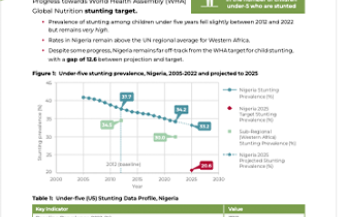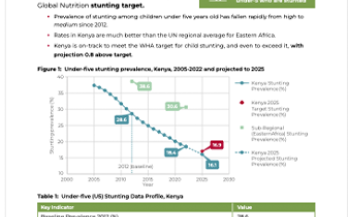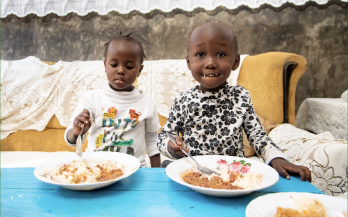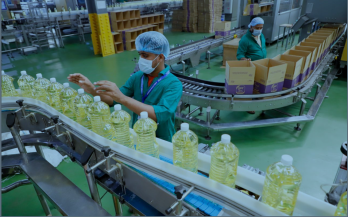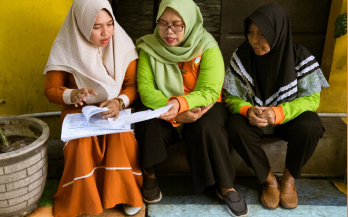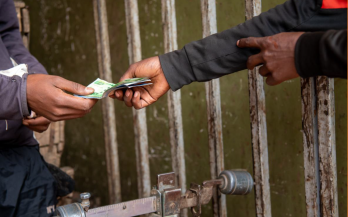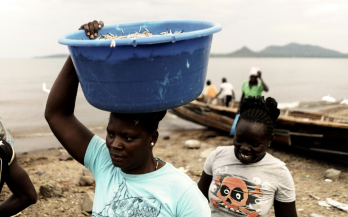WHA Global Nutrition Stunting Target 2012-2025
Achieve a 40% reduction in the number of children under-5 who are stunted
WHA Global Nutrition Overweight Target 2012-2025
Ensure that there is no increase in childhood overweight
WHA Global Nutrition Target 2012-2025
Achieve a 40% reduction in the number of children under-5 who are stunted
Overweight Target 2012-2025 Ensure that there is no increase in childhood overweight
WHA Global Nutrition Stunting Target 2012-2025
Achieve a 40% reduction in the number of children under-5 who are stunted
WHA Global Nutrition Overweight Target 2012-2025
Ensure that there is no increase in childhood overweight
Stunting and overweight in children under five years of age remain major malnutrition
challenges in the 12 countries in Africa and Asia where GAIN operates: Bangladesh, Benin,
Ethiopia, India, Indonesia, Kenya, Mozambique, Nigeria, Pakistan, Rwanda, Tanzania, and
Uganda. These forms of malnutrition appear in two of the six Global Nutrition Targets of
the World Health Assembly (WHA), which are meant to be achieved by 2025. This paper
evaluates progress towards these two WHA goals in these 12 countries, identifies lessons
learned, and offers actionable insights for evidence-based policymaking.
The Global Alliance for Improved Nutrition (GAIN) and Wellspring Development designed and hosted a series of in-person and online consultations with partners of the Dutch Ministry of Foreign Affairs to examine challenges in improving the quality of diets of population groups living in rural areas of Low and Lower-Middle Income countries. These groups still largely consume nutrient-inadequate, even unhealthy, diets and face heavy burdens of malnutrition. This sixth and final paper considers how to recognise and manage trade-offs that inevitably emerge in large scale programmes. The discussions focused on how to identify when trade-offs occur and possible ways of addressing these
The Global Alliance for Improved Nutrition (GAIN) and Wellspring Development designed and hosted a series of in-person and online consultations with partners of the Dutch Ministry of Foreign Affairs to examine challenges in improving the quality of diets of population groups living in rural areas of Low and Lower-Middle Income countries. These groups still largely consume nutrient-inadequate, even unhealthy, diets and face heavy burdens of malnutrition. This fifth paper, out of six, looks specifically at the challenges in managing complex programme comprising multiple components, as well as the roles played by external actors in programme success and how best to manage this. The aim of the discussions was to elaborate on the definitions of coordination and orchestration, gather examples where these have been done successfully and to understan
The Global Alliance for Improved Nutrition (GAIN) and Wellspring Development designed and hosted a series of in-person and online consultations with partners of the Dutch Ministry of Foreign Affairs to examine challenges in improved the quality of the diets of population groups living in rural areas of Low and Lower-Middle Income countries. These groups still largely consume unhealthy or even nutrient inadequate diets and face heavy burdens of malnutrition. This fourth paper looks specifically at the challenges of delivering impact at scale. The aim of the discussions was to gather examples of successful project interventions, to understand the decision processes of different organisations,
The Global Alliance for Improved Nutrition (GAIN) and Wellspring Development designed and hosted a series of in-person and online consultations with partners of the Dutch Ministry of Foreign Affairs to examine challenges in improving the quality of diets of population groups living in rural areas of Low and Lower-Middle Income countries. These groups still largely consume nutrient-inadequate, even unhealthy, diets and face heavy burdens of malnutrition. This third paper out of six, looks specifically at the role of markets in improving nutrition at scale. The aim of the discussions was to gather examples of projects that have delivered success at scale, to understand the challenges involved and to identify important points of convergence in conceptualisation and action in future work.
The Global Alliance for Improved Nutrition (GAIN) and Wellspring Development designed and hosted a series of in-person and online consultations with partners of the Dutch Ministry of Foreign Affairs to examine challenges in improving the quality of diets of population groups living in rural areas of Low and Lower-Middle Income countries. These groups largely consume nutrient-inadequate, even unhealthy, diets and face heavy burdens of malnutrition. This second paper, out of six, looks specifically at the challenges of defining and understanding different groups of rural populations. The aim of the discussions was to explore a range of approaches used in defining segments and implications of chosen segments for programme design to help the organisations involved understand how to incorporate these ideas in future work. The bulk of the discussion reflected in this paper is from an online meeting held on 30 September 2024, with the participation of the Dutch Ministry of Foreign Affairs, Bopinc, CARE Netherlands, East-West Seeds, GIZ, the Netherlands Food Partnership, One Acre Fund, and the Wageningen Centre for Development Innovation.
The Global Alliance for Improved Nutrition (GAIN) and Wellspring Development designed
and hosted a series of in-person and online consultations with partners of the Dutch
Ministry of Foreign Affairs to examine challenges in improving the quality of diets of
population groups living in rural areas of low- and lower-middle-income countries. These
groups largely consume nutrient-inadequate, even unhealthy, diets and face heavy
burdens of malnutrition. This first paper, out of six, looks specifically at the challenges of
setting targets for dietary quality improvement. The aim of the discussions was to gather
examples of successful project interventions at scale, to understand the decision
processes of different organisations, and to identify important points of convergence in
conceptualisation and action.
